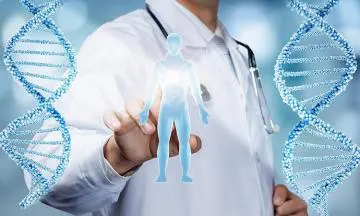

What are the common thyroid disorders?
Know about different types of thyroid disorders, causes and symptoms.
The thyroid (pronounced thy-royd) is a gland. It is shaped like a little butterfly. It resides in front of your neck. To find it, just touch your throat in the Adam’s apple area with one finger and the top of your breastbone - the flat bone that runs down the middle of your chest – with another finger. The thyroid gland is located in that small space in-between your fingers. It moves up and down when you swallow.
The thyroid gland produces two major hormones and releases into the bloodstream namely T3 (triiodothyronine) and T4 (thyroxine). All the cells in the body need thyroid hormones to work efficiently. The thyroid hormones manage how quickly the body uses up energy. They regulate our metabolism; they are also key factors in helping children grow.
Any imbalance of the two hormones, even if marginal, can trigger different types of thyroid disorders.
Hyperthyroidism
Hyperthyroidism, or thyrotoxicosis, results from excess thyroid hormones (T3 and/or T4). The disorder, a result of thyroid hyperfunction, falls into two groups: 1. Graves’ disease - characterised by toxic goitre and increased number of thyroid cells, which primarily affects women; and, 2. Plummer’s disease. This is characterised by overactive, or single and/or multiple nodules of the thyroid gland.
Hyperthyroidism affects women 5-10 times more commonly than men; it can occur at any age, although it’s common in the 20-40 age group.
Hyperthyroidism Symptoms
- Weight loss, tremors and protrusion of one or both eyeballs (exophthalmos)
- Extreme weakness
- Excessive sweating
- Heat intolerance
- Palpitation, breathing difficulty, diarrhoea, or increased frequency of bowel movements.
Note: It is unusual for a newborn to have hyperthyroidism, or neonatal Graves’ disease. The condition may, however, occur when the mother has Graves’ disease during pregnancy, or has undergone treatment for the condition before pregnancy. In Graves’ disease, the woman’s body typically produces antibodies that stimulate the thyroid gland to produce increased blood levels of thyroid hormones. The antibodies cross the placenta and affect the foetus. In the affected newborn, the metabolic rate may be too high and accompanied by rapid heart rate; the breathing may be quick too. There may be irritability accompanied by excess appetite, with little or no weight gain.
Hyperthyroidism can affect all the systems in the body - however, the most important signs and symptoms relate to the cardiovascular (heart) and neuropsychiatric (nerve- emotional) symptoms.
The appearance and general behaviour of the individual may also clinch the diagnosis - the patient often presents with a wide-eyed, hollow-cheeked, agitated, restless, trembling appearance with rapid, bounding carotid artery (located in the front of the neck) pulsations.
Hypothyroidism
Hypothyroidism is a condition in which the body lacks sufficient thyroid hormones. It leads to clinical signs of thyroid deficiency - low metabolic rate, weight disorders (obesity), sleepiness, and sometimes myxoedema, a relatively hard swelling of the subcutaneous tissue characterised by thickening of the skin, blunting of the senses and intellect, including laboured speech.
Hypothyroidism affects about 10 per cent of women worldwide - and about 3-5 per cent of the general population. It often goes unnoticed - even though it makes one feel persistently weak and tired.
The causes of hypothyroidism may tag along certain disorders of the hypothalamus or the pituitary gland. It is typified by reduced secretion of the thyroid stimulating hormone (TSH). It may, likewise, be caused because of idiopathic agenesis (unknown cause or absence, or failure of formation), or imperfect development of the thyroid gland, or atrophy (wasting).
Hypothyroidism Symptoms
The symptoms of hypothyroidism are often present for years before a diagnosis is made. This is often due to the fact that symptoms are frequently imprecise and blurred and/or attributed to non-specific causes.
- Extreme Fatigue
- Physical and mental sluggishness
- Muscular pain, menstrual problems and hair loss
- Constipation
- Angina (chest pain), including heart failure.
- The trademark signs may include a gruff voice, puffy eyes; other gross features may include slowness of expression and movements.
- Dry, scaly, cold and thickened skin - this is called as ‘strawberries-and-cream’ facial appearance; or, pale expression.
- Scalp hair may be coarse or brittle
Goitre
Goitre is the enlargement of the thyroid gland. Though not usually uncomfortable, it may have a tendency to hinder your swallowing and breathing activities. The development of goitre does not, in essence, mean that your thyroid gland isn’t producing hormones in normal quantity.
The fact sometimes is - an enlarged thyroid may produce less-than-normal, normal- or higher-than-normal amounts. Sometimes, the enlargement of the gland can be uniform. This is called diffuse goitre. In certain cases, the gland may be enlarged due to one or more nodules, or lumps, within a normal thyroid gland. This is called nodular goitre.
The word goitre comes from the Latin, guttur - for ‘throat.’ Before the early part of the last century, the most common cause of goitre was lack of iodine in the diet - especially in areas where the soil was lacking iodine. The inference is obvious - without adequate dietary iodine, your thyroid gland cannot manufacture and release enough of the two essential iodine-containing hormones.
Goitre may often be seen in individuals who present with a kind of Parkinsonian tremor. The common eye sign is a prominent stare. Most individuals also have a rapid pulse. This may be because of sinus tachycardia (rapid beating of the heart), or atrial fibrillation, in which the normal rhythmical contractions of the heart are replaced by rapid irregular twitching of its muscular wall.
Goitre became infrequent after iodised salt was first introduced in the early 1900s. Yet, the fact is goitre remains a common disorder in some parts of the world, because of iodine insufficiency. There is also an established link between hard, fluoride-containing drinking water and the prevalence of goitre. The incidence is, however, infrequent in areas with soft water and low fluoride levels.
Myxoedema
Myxoedema, a severe form of hypothyroidism, may present with several neurological symptoms. These include - carpal tunnel syndrome (this is caused when the median nerve, which runs from the forearm into the palm of the hand, becomes pressed or squeezed at the wrist) and polyneuritis (pain in several peripheral nerves at the same time). Other neurological symptoms that may be present are: slurred speech and ataxia, or lack of muscle co-ordination which may affect speech, eye movements, ability to swallow, walking, picking up objects, muscle cramps and stiffness, and loss of muscle tone. There may also be a delay in the relaxation phase of the ankle jerk, which your doctor will elicit. The disorder may present with anaemia and unusual psychiatric features or behaviour - ‘myxoedema madness.’
Hair Loss & Thyroid
Research suggests that nearly half of all adults experience thinning of hair by age 40. Also, about 20 per cent of individuals with thyroid disorders are evidenced to experience hair loss earlier and more quickly than the others. Hair loss, therefore, tends to persist in thyroid patients, notwithstanding appropriate treatment. Most patients do not often realise that their hair loss may be triggered by a thyroid disorder.
In The New Born
Hypothyroidism in the newborn could lead to poor growth and delayed mental milestones. This can, in due course, lead to mental retardation. The most common cause of hypothyroidism in the newborn is complete absence, or underdevelopment, of the thyroid gland. The downside is the newborn may show no symptoms. Diagnosis is often made when classical symptoms of lethargy, poor appetite, constipation, a hoarse cry, umbilical hernia - bulging of the abdominal contents where the umbilicus penetrates the abdominal wall - make their presence, along with slow physical growth, more so when the infant develops crude facial features along with a swollen tongue. A blood test on the newborn is a procedure of choice - it helps to measure thyroid hormone levels and also institute appropriate, prompt treatment to prevent mental retardation.




